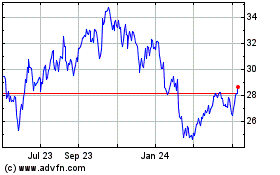North Sea Helicopter Operators Making Backup Plans After Norway Crash -- 2nd Update
02 May 2016 - 2:35AM
Dow Jones News
By Robert Wall, Kjetil Malkenes Hovland and Andy Pasztor
Helicopter operators serving the North Sea offshore oil and gas
industry are scrambling to make backup plans after the grounding of
one of their most commonly used models following a fatal crash on
Friday as crash investigators step up efforts to determine why the
machine went down.
An Airbus Group SE EC225 flown by CHC Helicopter Services
crashed while flying to Bergen Airport from Statoil ASA's Gullfaks
B oil field, killing all 13 people onboard. Norwegian and British
air safety regulators imposed a ban on all EC225 passenger
flights.
The cause of the accident is still not known, though the
helicopter has been plagued by problems with its main gearbox that
drives the rotors.
CHC on Sunday said it was bringing in extra helicopter capacity
including S-92s from Lockheed Martin Corp.'s Sikorsky helicopter
unit and a Finmeccanica SpA AW139.
"We are also working on a strategic plan to provide a robust
longer term solution," the company said.
Babcock MCS Offshore, another major operator of offshore
flights, said it had ceased operations four EC225 helicopters flown
in the U.K.
"We are working closely with our customers to provide them with
an operational alternative," it said.
The Accident Investigation Board Norway on Sunday said it was
uncertain how long the crash probe might take, though it could be
more than a year.
The process to extract information from the combined cockpit
voice and flight-data recorder has started, it said. The so-called
black box should provide the strongest clues to why the EC225
crashed.
The recorder is being read by Britain's Air Accident
Investigations Branch, which is aiding the probe.
"Any critical safety information will be communicated.
Completing a full investigation including all the factors leading
up to the accident will take time, experience suggests at least 12
months," Norway's crash investigators said.
The speed with which the emergency grounding--especially of a
widely used aircraft--was ordered is unusual given investigators
haven't released preliminary findings. The move partly reflects the
large number of fatalities, representing what is believed to be the
second-largest loss of life in more than two decades involving the
specific model or its predecessors.
The crash also has raised concerns among safety experts because
early signs point to apparent separation of a rotor from the
helicopter before impact--an unusual type of accident. At least one
unofficial video of the crash shows the rotor descending on its
own, and eyewitnesses described its location as hundreds of meters
away from the main wreckage.
In addition, in a safety bulletin Airbus issued to its
customers, the manufacturer indicated it didn't have any
information about why the rotor seemingly broke off before the
accident. A catastrophic rupture of that kind is comparable to an
engine tearing off the wing of a modern jetliner--something that
designers and operators consider virtually impossible.
Over the years, the Super Puma model has been the focus of
extensive safety initiatives by industry as well as regulators from
various countries.
The crash occurred roughly three years after offshore
helicopters in the North Sea--joining forces with Norwegian and
British authorities--launched a campaign to reassure workers about
the safety of the workhorse choppers following a number of
accidents and incidents. That effort resulted in operational and
pilot-training changes, in addition to heightened regulatory
oversight.
The AIBN said it also is being assisted by its French
counterpart. Norway's Civil Aviation Authority and EASA would also
participate, it said.
Local police said on Sunday they were still looking for
additional helicopter parts at the crash site, and that remotely
operated underwater vehicles were searching the sea bottom to
retrieve the shattered remains of the aircraft. Police said the
helicopter's main body had been retrieved.
The parts are being taken to the Haakonsvern naval base in
Bergen for examination.
A national police ID team said it hadn't yet identified the 13
people who were on board, one female and 12 men, but all are
assumed dead.
The helicopter carried oil workers from Statoil's Gullfaks B
offshore platform, including employees of companies including
Halliburton, Aker Solutions, Schlumberger, Welltec, Karsten Moholt
and Statoil. The two pilots were employed by CHC.
Including Friday's crash, 59 people have died in helicopter
accidents in Norway's offshore sector over the last five decades,
or 21% of the country's total offshore fatalities, according to the
Norwegian Petroleum Safety Authority. The previous fatal chopper
accident off Norway happened in 1997.
Write to Robert Wall at robert.wall@wsj.com and Kjetil Malkenes
Hovland at kjetilmalkenes.hovland@wsj.com
(END) Dow Jones Newswires
May 01, 2016 12:20 ET (16:20 GMT)
Copyright (c) 2016 Dow Jones & Company, Inc.
Equinor ASA (NYSE:EQNR)
Historical Stock Chart
From Mar 2024 to Apr 2024

Equinor ASA (NYSE:EQNR)
Historical Stock Chart
From Apr 2023 to Apr 2024
